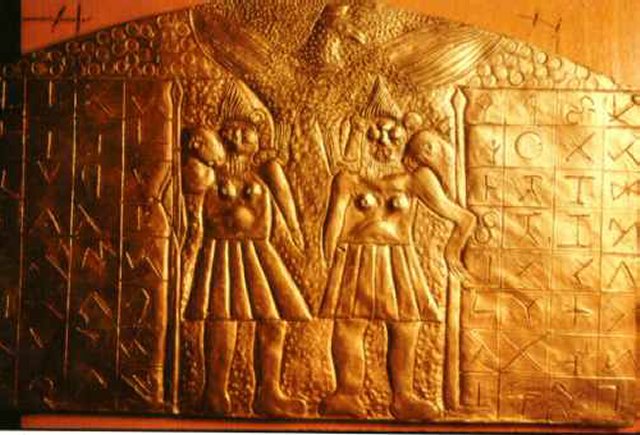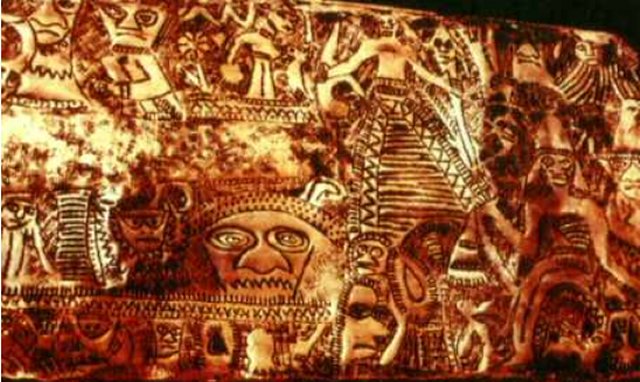First version of this article was originally published on November 21, 2014
MessageToEagle.com – Father Crespi’s collection originally consisted of more than 70,000 artifacts.
Many of them are unique and show evidence of advanced science possessed by an ancient civilization or perhaps more civilizations unknown to us.
The most controversial items are metal sheets of copper, brass and other alloys. The motifs on artifacts are strange, their meaning has never been understood.
Were they left by an unknown civilization or perhaps more ancient civilizations?

No matter whether they are pieces of metal, ceramics, wood, stone or animal bones, they are still intriguing. Where did Father Crespi’s treasures come from?
How old are they? Father Crespi never tried to classify them and nobody ever tried to help him to do it. Science does not care and the artifacts’ authenticity will never be proven.
Many of them were destroyed, as many say, by intentional fire or permanently damaged by treasure hunters.
There are diverse stone tablets inscribed with sun symbols and hundreds of gold plates representing moon suns, stars, crescents and serpents.

There is also a gold plate that depicts a pyramid and elephants which were unknown in South America 12,000 years ago.
At this time, it was considered that no civilization existed in this corner of our planet.
Many metal artifacts were used to repair the church’s floor. Many of them originated from the Antediluvian World.
Father Carlo Crespi (born in 1891, in Legnano, Italy) lived in the small town of Cuenca, Ecuador, for many years. He was a priest of the Church of Maria Auxiliadora and a competent archaeologist. He collected all the gifts given to him from the local Indians who gathered them in secret hidden places.
Finally he received permission from the Vatican to open a museum in the Salesian School at Cuenca. On 20th July 1962, there was fire and Crespi’s museum was burnt down. Father Crespi managed to salvage many artifacts and stored them in two long and narrow rooms.
In the late 1970’s J. Golden Barton visited Father Crespi in a Catholic “College of Salesino” and so he said a few years later:
“He led us into an inner court of the school yard, where old Spanish wooden doors faced inward, and the oft-scrubbed floors gleamed with sunlight bouncing off the polished terrazzo. We were unprepared for what was to come. Father Crespi took a large key from a ring that hung from a braided belt around his robe, then moved to an obscure wooden door and turned the lock. Together with a single helper, he disappeared into the dark room.
Both soon reappeared with a large piece of metal that had been molded and hammered into a long sheet. It looked like it might be made of gold. The sheet was inscribed with a curious artwork beyond identification.
“Next, they dragged something from the darkness too large to be carried, and only with strenuous exertions were they able to lean it against the stucco wall. It stands twenty-two inches high and about seven inches wide its weight must have been prodigious.
I reached my hand to touch the object and noticed it featured a dark covering, as if it had been painted. At first, I supposed it must have been made of lead, because it was soft and almost pliable. Then the nails of my fingers bit into the body of the figure through the paint and the gleam from the tell-tale scratch left no doubt that it was made of pure gold…”
“Let the Vatican grail guardian Father Crespi of Cuenca be the key witness to the pre-Christian origin of the metal treasures. He said to me: “Everything that the Indians brought me from the tunnels dates to before Christ. Most of the symbols and pre-historic representations are older than the Flood,” wrote Erich von Däniken in his book “Gold of the Gods”.
“Stacked from floor to ceiling were hundreds of large cardboard pieces on which were wired metal bracelets, earrings, nose rings, and necklaces, some untarnished by time. Hide-scrapers, tools, implements of war, spears, axes, clubs, of wood, metal and stone were stacked everywhere. Father Crespi’s mysterious room seemed overburdened with the treasures of an unknown antiquity. It literally over-flowed with bizarre artifacts, many wrought in precious metals.
Most intriguing were the innumerable plates of bronze, brass and gold. Many bore strange inscriptions and hieroglyphic symbols. Others were replete with the engravings of incongruous animals–elephants, snakes, jaguars, wild beasts of every kind. The images of horse-drawn chariots were clearly etched into metal, calling to mind Juan Moricz’s description of “a Roman chariot” in his underground chamber…”
A number of gold plates are covered with graphic characters which may be some kind of ancient writing that probably is oldest ever known in the world! One of the golden plates is subdivided in 56 squares, each one filled with a different graphic character.
See also:
11 Extraordinary Out-Of-Place Artifacts That Science Cannot Explain
Would it mean this ancient unknown writing was composed of 56 symbols or letters?After Father Crespi passed away, the relics, golden artifacts were no longer available for public view and the sealed room was no longer open to those acquainted with Crespi.
Finally Crespi’s mysterious collection was shipped by the Catholic Church to Rome.
Copyright © MessageToEagle.com All rights reserved. This material may not be published, broadcast, rewritten or redistributed in whole or part without the express written permission of MessageToEagle.com.
source: Erich von Däniken “Gold of the Gods”.






